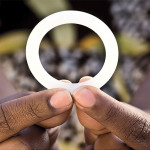The future of both HIV and pregnancy prevention among women may be in an intravaginal ring that appears to boast three months of staying power. A recent animal study of a ring that emits both the antiretroviral tenofovir and the contraceptive levonorgestrel was promising, showing that the ring released adequate levels of both drugs.
A major frustration in the attempt to prevent the spread of HIV among women, particularly those in developing nations, has been the lack of a discrete and inexpensive method that women can control.
Describing herself as “cautiously optimistic” about the ring’s initial trial, lead researcher Meredith Clark, PhD, of CONRAD, the reproductive health research group, said the women in the study’s target demographic “are vulnerable for a reason: They have little to no negotiation power with their partners, and they are often undereducated and economically disadvantaged. These women have historically been unable to choose when to have children and, tragically, have been unable to protect themselves from HIV because their partners may refuse to wear condoms.”
A clinical trial in women is set to begin in early 2014.
Vaginal Ring Prevents HIV and Pregnancy






Comments
Comments